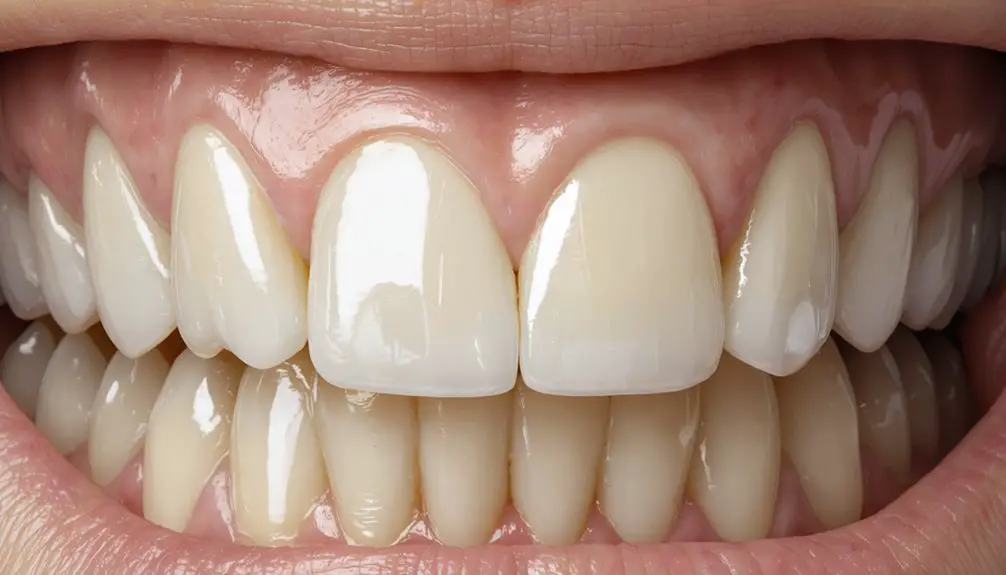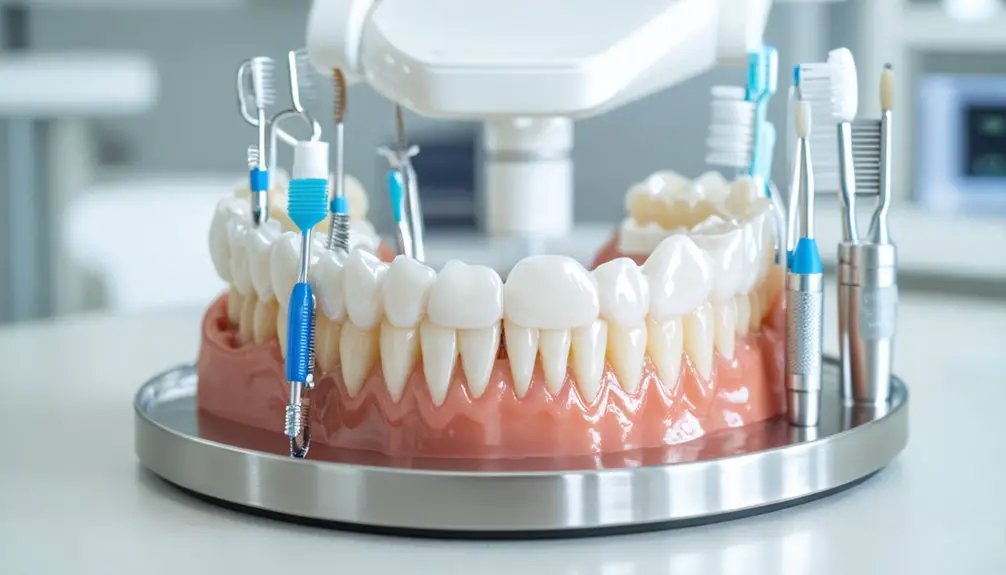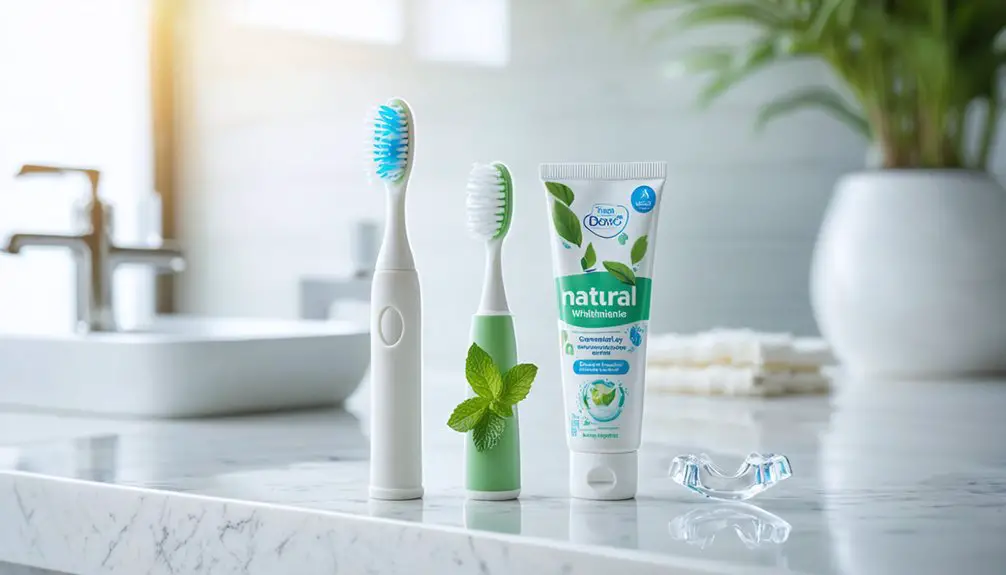Teeth whitening treatments use peroxide-based agents that penetrate your enamel to break down stains through oxidation. While effective, these agents can temporarily increase enamel porosity and create an acidic environment below pH 5.5, leading to demineralization and weakening of your tooth structure. When combined with dietary acids or repeated treatments without adequate recovery time, you’ll face heightened risks of permanent enamel erosion. Understanding the chemical mechanisms can help protect your long-term dental health.
Key Takeaways
- Whitening agents contain peroxides that penetrate enamel, generating free radicals that break down stains but also demineralize tooth structure.
- pH levels below 5.5 during whitening create an acidic environment that accelerates enamel erosion and mineral loss.
- Repeated whitening sessions without adequate recovery time progressively weaken enamel structure and increase surface porosity.
- Whitening treatments temporarily increase enamel vulnerability, making teeth more susceptible to damage from acidic foods and beverages.
- Chemical agents in whitening products can alter tooth surface morphology and mineral density, potentially causing permanent damage to non-regenerative enamel.
The Chemical Impact of Whitening Agents on Tooth Enamel
While teeth whitening has become increasingly popular in recent years, the chemical mechanisms behind these treatments can profoundly impact your tooth enamel.
When you use whitening products, agents like hydrogen peroxide and carbamide peroxide penetrate your enamel to reach deeper stains. These chemicals generate free radicals that break down stain molecules through oxidation, but they can also trigger concerning structural changes.
The whitening ingredients’ toxicity can lead to demineralization and deproteinization of your tooth structure. Over-the-counter products with undisclosed concentrations present significant risks.
You’ll find that higher concentrations of peroxide-based agents particularly disturb enamel’s surface topography and increase its porosity. This risk increases significantly when the pH drops below 5.5, creating an acidic environment that accelerates enamel erosion.
While current enamel regeneration techniques show promise, they can’t fully reverse this damage.
That’s why it’s essential to choose professional treatments with controlled concentrations rather than unrestricted DIY methods.
Understanding Ph Levels and Mineral Loss During Treatment
When teeth whitening agents interact with your enamel, their pH levels play an essential role in determining both safety and effectiveness. Your teeth begin to lose minerals when exposed to solutions with pH below 5.5, which can compromise enamel integrity.
The ideal whitening pH range lies between 4.5 and 5.5, balancing bleaching efficacy with enamel protection. Hydrogen peroxide agents are commonly used in professional and at-home whitening treatments to break down stain molecules. Natural alternatives like baking soda provide gentler whitening with neutral pH levels.
For optimal teeth whitening results while safeguarding enamel health, maintain bleaching agents within a pH range of 4.5 to 5.5.
You’ll risk accelerated enamel erosion if you use products with pH below 4.5 or combine whitening treatments with acidic foods and beverages. Environmental factors like temperature changes and oral conditions such as acid reflux can further disrupt pH balance.
To protect your enamel during whitening, focus on mineral replenishment through fluoride or calcium phosphate treatments, and carefully monitor product pH levels and exposure times.
How Repeated Whitening Sessions Affect Enamel Integrity
Your enamel’s mineral content gradually depletes with each whitening session, leading to microscopic structural changes that compromise its protective capabilities.
When you undergo repeated treatments without adequate recovery periods, you’re extending the time your teeth spend in a vulnerable state of increased porosity and reduced density. Hydrogen peroxide penetration through enamel increases with frequent whitening, accelerating mineral loss.
The cumulative effect weakens your enamel’s natural defense system against decay, making your teeth more susceptible to damage from everyday activities like chewing and exposure to acidic foods. Since enamel is non-regenerative tissue, any damage from excessive whitening treatments becomes permanent.
Cumulative Mineral Loss Effects
Although teeth whitening procedures can deliver dramatic cosmetic results, repeated exposure to bleaching agents poses significant risks to your enamel’s mineral structure.
The cumulative effects of multiple whitening sessions can lead to progressive weakening of your tooth enamel, especially when using products with high peroxide concentrations or acidic pH levels below 5.5. Whitening agents containing hydrogen peroxide compounds penetrate deeply into the enamel to break down stains.
Your enamel’s vulnerability increases with each treatment as the bleaching agents cause temporary demineralization, making the surface more porous and susceptible to mineral loss. Professional oversight through dental consultation visits can help minimize these risks by monitoring enamel health and adjusting treatment protocols accordingly.
This process creates lasting microstructural changes in your enamel crystals, particularly when whitening products lack remineralizing agents like fluoride or calcium.
The combination of chemical exposure and mechanical abrasion from whitening toothpastes can further accelerate enamel erosion, potentially compromising your teeth’s long-term health and structural integrity.
Extended Treatment Time Impact
Extended exposure to teeth whitening treatments poses compounding risks to your enamel’s structural integrity over time.
When you undergo frequent whitening sessions, your teeth’s protective capacity diminishes, making them more susceptible to acid erosion and mechanical wear. These extended treatment consequences manifest through increased enamel permeability and disrupted crystal structures at the microscopic level. The most damaging effects occur when using high peroxide concentrations in whitening products. Dentists recommend spacing out treatments to allow proper enamel recovery between sessions.
Your enamel vulnerability factors multiply as repeated exposure to peroxide-based agents interferes with natural remineralization processes.
The breakdown products create microscopic surface defects, while your enamel’s ability to recover between sessions becomes compromised. You’ll notice heightened sensitivity and potential translucency as the cumulative effects of prolonged whitening alter your teeth’s surface morphology and mineral density.
Professional guidance remains essential to prevent irreversible damage from excessive treatment duration.
Weakened Structural Defense Pattern
Repeated whitening sessions fundamentally alter enamel’s microstructure, compromising its defense mechanisms against external threats.
When you frequently expose your teeth to bleaching agents, you’ll create structural vulnerability that weakens enamel resilience over time.
Your teeth’s protective barrier deteriorates through three distinct processes:
- Peroxide agents penetrate enamel, increasing porosity and disrupting its crystalline structure.
- Acidic byproducts lower pH levels, accelerating mineral dissolution and surface erosion.
- Abrasive ingredients mechanically wear down enamel, thinning its protective layer.
This cumulative damage reduces your enamel’s density and compactness, making teeth more susceptible to decay and sensitivity.
Since enamel can’t regenerate, it’s essential to limit whitening frequency and follow professional guidance to preserve your teeth’s long-term health.
The Role of Dietary Acids in Amplifying Erosion Risk
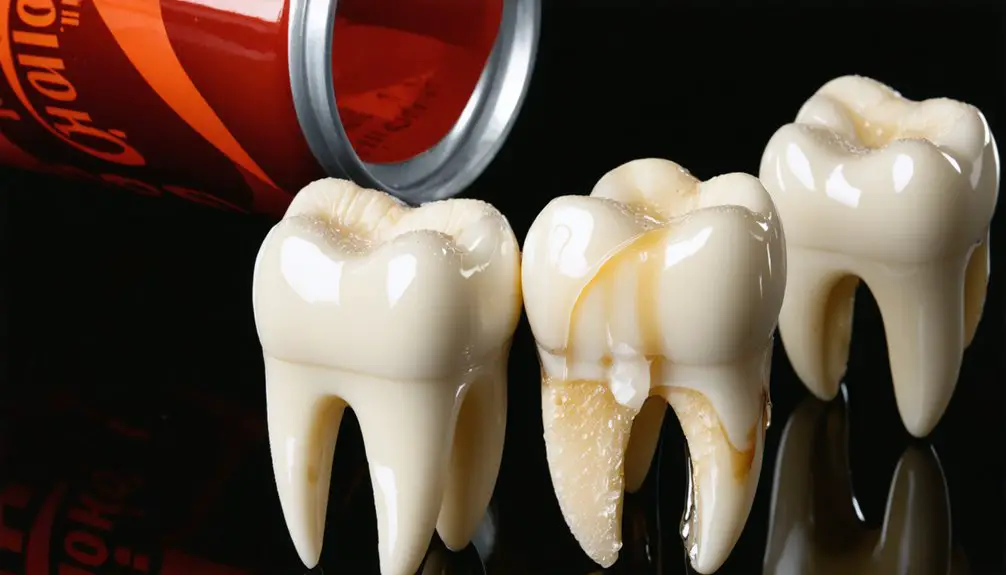
When you undergo teeth whitening treatments, your enamel becomes temporarily more vulnerable to acid damage, making it critical to avoid acidic foods and beverages during this period.
The combination of whitening agents and dietary acids can accelerate enamel erosion, as the peroxide-softened enamel is less resistant to acid attacks.
You’ll need to modify your diet to exclude acidic items like citrus fruits, sodas, and sports drinks both during whitening treatments and for several days afterward to protect your enamel’s integrity.
Acidic Foods During Whitening
During teeth whitening treatments, acidic foods and beverages pose a significant threat to your enamel integrity by amplifying erosion risks.
Your teeth become especially vulnerable when whitening agents increase enamel porosity, making acidic snacks particularly damaging. Without sufficient enamel recovery time between exposures, repeated acid attacks can overwhelm your mouth’s natural protective mechanisms.
Consider these critical impacts of acids during whitening:
- Whitening agents combined with acidic foods accelerate enamel softening, leading to faster mineral loss.
- Acid-weakened enamel absorbs stains more readily, diminishing your whitening results.
- The combination of acids and whitening compounds heightens tooth sensitivity, potentially causing significant discomfort.
To protect your teeth, avoid acidic foods during treatment and maintain adequate intervals between meals for proper remineralization.
Combined Erosion Effects Explained
The combined effects of whitening agents and dietary acids create a particularly destructive environment for your tooth enamel.
When you expose your teeth to acidic foods or drinks after whitening, you’re intensifying potential damage because whitening treatments temporarily increase your enamel’s porosity. This makes your teeth more vulnerable to acid penetration and erosion.
Your natural saliva plays an essential protective role by neutralizing acids and promoting remineralization, but whitening can temporarily impair this defense mechanism.
To protect your enamel, you’ll need to limit acidic exposure during and after whitening treatments. Using professional-grade remineralization agents and focusing on saliva stimulation can help counteract these effects.
The key is understanding that whitening and dietary acids work synergistically to amplify enamel erosion risks.
Preventive Diet Modification Steps
Since dietary acids pose a considerable threat to tooth enamel during whitening treatments, you’ll need to make strategic modifications to your eating and drinking habits.
These preventive strategies focus on minimizing acid exposure and maximizing enamel protection through smart dietary modifications.
Your patients should implement these essential changes:
- Eliminate or considerably reduce consumption of acidic beverages (sodas, fruit juices, wine) with pH below 5.5
- Use straws when drinking acidic beverages to bypass direct tooth contact
- Wait 30 minutes after consuming acidic foods before brushing to prevent damage to softened enamel
Additionally, encourage increased water consumption after acidic foods to neutralize oral pH and boost protective saliva flow.
Recommend calcium-rich foods to support enamel remineralization, and suggest replacing acidic snacks with enamel-friendly alternatives like nuts and dairy products.
Microstructural Changes in Enamel After Bleaching

Bleaching treatments greatly alter tooth enamel’s microstructural properties, particularly when using high-concentration hydrogen peroxide solutions.
You’ll find that these changes manifest through increased enamel porosity changes and surface roughness, making teeth more vulnerable to mechanical wear and acid erosion. Higher concentrations of bleaching agents create more severe alterations in the enamel’s crystal structure.
Your enamel’s microhardness considerably decreases within 24 hours of treatment, especially with 35% hydrogen peroxide solutions.
Tooth enamel becomes significantly softer in the first day after bleaching, particularly when using high-strength peroxide treatments.
While some recovery occurs after a week in the presence of saliva, the structural modifications can leave teeth susceptible to demineralization.
Professional treatments typically cause less damage than poorly regulated over-the-counter products.
These microstructural alterations directly contribute to increased erosion risks, as the disrupted crystalline arrangement and mineral density changes compromise your enamel’s protective properties.
Signs of Enamel Damage During Whitening Procedures
While tooth whitening procedures can effectively brighten your smile, recognizing signs of enamel damage during treatment remains essential for protecting long-term dental health.
When using whitening techniques, you’ll need to monitor your teeth for potential enamel sensitivity and structural changes.
Watch for these key indicators of enamel damage:
- Sharp sensitivity to hot, cold, or sweet substances, which often signals nerve irritation and weakened enamel protection.
- Development of white spots or uneven coloration on tooth surfaces, indicating areas of mineral loss and demineralization.
- Rough or irregular tooth texture that you can feel with your tongue, suggesting surface erosion and compromised enamel integrity.
If you notice these signs, consult your dental professional immediately to prevent further damage and adjust your whitening approach.
Professional vs. Over-the-Counter Treatment Safety
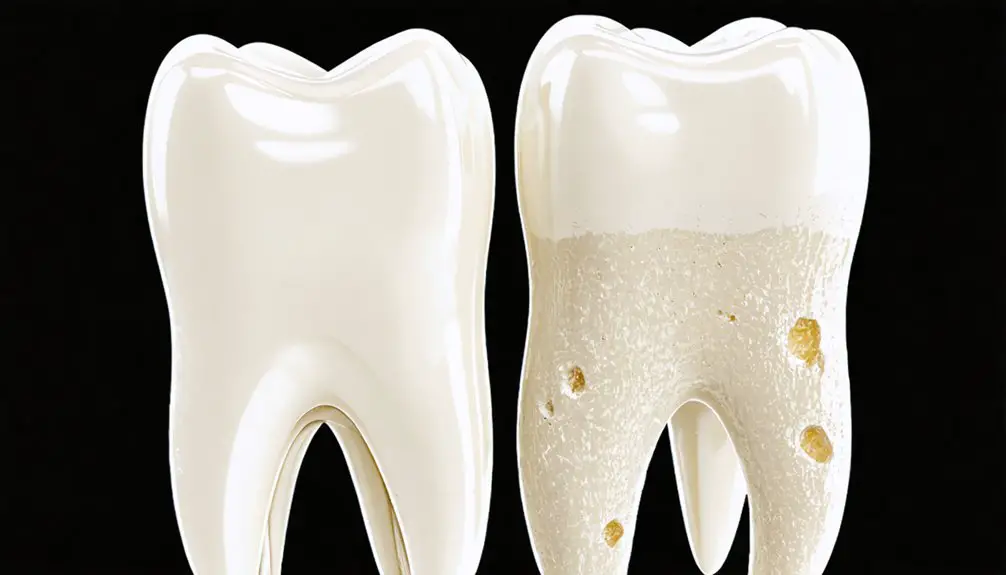
To protect your dental health during whitening treatments, understanding the key differences between professional and over-the-counter options remains crucial.
Professional supervision guarantees carefully controlled concentrations of bleaching agents while incorporating protective barriers and specialized additives to minimize enamel damage. Your dentist will customize application times and strengths specifically for your needs.
In contrast, OTC products often lack proper product regulation, leading to potential misuse and increased risks. Without professional oversight, you’re more likely to experience enamel softening, heightened sensitivity, and uneven results.
OTC whitening toothpastes may contain abrasive agents that wear down enamel over time. The absence of clear guidelines on frequency and duration can result in overexposure, making your teeth more susceptible to future staining and sensitivity.
Prevention Strategies for Protecting Tooth Enamel
Protecting your tooth enamel requires a thorough preventive approach that combines proper oral hygiene techniques, dietary modifications, and professional dental care.
A comprehensive enamel protection strategy integrates daily oral care habits, smart food choices, and regular visits to dental professionals.
When pursuing teeth whitening, proper enamel care becomes even more critical to maintain whitening safety and prevent sensitivity.
To safeguard your enamel during whitening treatments:
- Wait at least 30 minutes after consuming acidic foods before brushing, allowing your saliva’s natural remineralization process to work.
- Use a soft-bristled toothbrush with gentle circular motions instead of aggressive scrubbing to prevent mechanical wear.
- Incorporate fluoride products daily, including toothpaste and mouthwash, to strengthen enamel resistance.
Stay hydrated and maintain healthy saliva production by drinking plenty of water throughout the day.
Consider professional fluoride treatments and dental sealants for additional protection against enamel erosion.
Frequently Asked Questions
Can Whitening Treatments Make Teeth More Susceptible to Cavities?
Your smile’s protective barrier weakens when whitening agents temporarily increase enamel permeability, making your teeth more vulnerable to decay. You’ll need extra diligence with cavity prevention after treatments.
How Long Should I Wait Between Professional Whitening Treatments?
You should maintain 6-12 month treatment intervals between professional whitening sessions. This whitening frequency protects your enamel health while ensuring lasting results. Consult your dentist for personalized timing recommendations.
Does Teeth Sensitivity After Whitening Indicate Permanent Enamel Damage?
Like a window’s temporary frost, your sensitivity signs after whitening don’t mean permanent damage. Your enamel health typically returns as the whitening agents clear and natural remineralization occurs within days.
Are Natural Whitening Methods Like Oil Pulling Safer for Enamel?
While oil pulling won’t harm your enamel, its whitening efficacy remains scientifically unproven. You’ll get safer results with natural alternatives than peroxide treatments, but expect minimal visible improvement in tooth color.
Can Damaged Enamel From Whitening Treatments Regenerate on Its Own?
No, your enamel can’t truly regenerate – it’s acellular. While surface remineralization occurs naturally through saliva and fluoride, controlling whitening frequency is essential since deep enamel damage is permanent and irreversible.
References
- https://pmc.ncbi.nlm.nih.gov/articles/PMC3652357/
- https://www.webmd.com/oral-health/guide/tooth-enamel-erosion-restoration
- https://www.mesillavalleydentist.com/all-about-enamel-erosion-causes-and-prevention/
- https://pinegrovefamilydental.com/a-gem-of-a-smile-teeth-whitening-and-enamel-erosion/
- https://www.eastridgedentalgreenbay.com/teeth-whitening-cause-enamel-loss/
- https://sandlakedental.com/blog/understanding-the-science-behind-teeth-whitening/
- https://pmc.ncbi.nlm.nih.gov/articles/PMC10814888/
- https://bellevuedentaloasis.com/blog/teeth-whitening-ingredients-to-avoid/
- https://www.nature.com/articles/4813423
- https://ec.europa.eu/health/scientific_committees/opinions_layman/en/tooth-whiteners/l-3/5-tooth-whitening-products.htm
